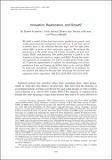Innovation, Reallocation, and Growth
Author(s)
Acemoglu, K. Daron; Akcigit, Ufuk; Alp, Harun; Bloom, Nicholas; Kerr, William
DownloadPublished version (854.7Kb)
Terms of use
Metadata
Show full item recordAbstract
We build a model of firm-level innovation, productivity growth, and reallocation featuring endogenous entry and exit. A new and central economic force is the selection between high- and low-type firms, which differ in terms of their innovative capacity. We estimate the parameters of the model using US Census microdata on firm-level output, R&D, and patenting. The model provides a good fit to the dynamics of firm entry and exit, output, and R&D. Taxing the continued operation of incumbents can lead to sizable gains (of the order of 1.4 percent improvement in welfare) by encouraging exit of less productive firms and freeing up skilled labor to be used for R&D by high-type incumbents. Subsidies to the R&D of incumbents do not achieve this objective because they encourage the survival and expansion of low-type firms.
Date issued
2018-11Department
Massachusetts Institute of Technology. Department of EconomicsJournal
American Economic Review
Publisher
American Economic Association
Citation
Acemoglu, Daron et al., "Innovation, Reallocation, and Growth." American Economic Review 108, 11 (November 2018): 3450-91 ©2018 Authors
Version: Final published version
ISSN
1944-7981